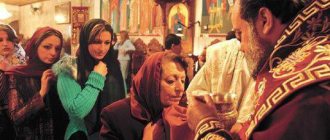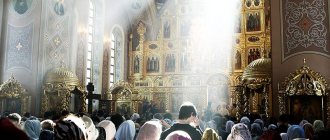Ecumenical Councils. Rules and heresies
The first Ecumenical Council was convened in the 4th century, the last one a little more than 400 years later. Since then, for about 1200 years, these meetings of the fullness of the Church have not been convened. Does this mean their era is over?
Ecumenical Council in Nicaea 325 Ecumenical Council. Definition.
The word “Ecumenical” literally means “universal”, for since ancient times the “Universe” was not called space, as it is now, but the world known to man of that time. Most often it was associated with the territory of the Roman Empire, the only powerful world power, on whose territory from the 1st century. Christian faith spreads.
Thus, the “Ecumenical” is considered to be a meeting of bishops - primates of local Churches who represent the fullness of the Christian Church.
However, from a human point of view, there is quite a lot that is unclear. For example:
- there are no canonical criteria for the order of convening; all seven of the now known as Ecumenical Councils met on the initiative of the emperors of Byzantium, however, this does not mean at all that the Council has the right to convene only secular power, and this cannot be done, for example, by one of the Local Churches;
- There are also no criteria by which such a meeting is recognized as Ecumenical, and its decisions are binding; the number of participants representing the Churches is not such a criterion: cases are well known when very representative meetings of bishops adopted decisions that contradict Christian teaching, and were later even considered “robbery”.
In fact, the only “human” criterion of “universality” is the recognition (“reception”) of definitions by the entirety of the Church. This can happen either immediately or after years, even decades. And often it won’t happen at all. For example, a kind of application for the status of the Ecumenical (Eighth) was made by the Ferraro-Florence Council, at which the union of the Orthodox Church with the Catholic Church was signed (1439), but was immediately rejected by believers.
But there is another criterion, beyond reasoning “from the mind.” It dates back to the Apostolic Age, when the disciples of Christ gathered for the first time to resolve general church issues. It was then that the definition formula arose: “It pleased the Holy Spirit and us” (Acts 15:28). It says that the correctness of decisions is determined from above, thus, this highest governing body of the Church is not of human origin, but so are its decisions.
It is this circumstance that causes (from the human side) the legal uncertainty of the status, order of convening, representation, powers, and criteria of truth. Christian ideas about all these points are based, “humanly speaking,” on historical precedents, and not on any legal documents.
Who signs the decisions of the Ecumenical Council?
This has always been done by the bishops participating here. Decisions recognized by the fullness of the Church also bear the signatures of the emperors of Byzantium, however, this only means that the decisions taken receive the force of the law of the empire, and not that they require the approval of secular authorities.
Who can take part?
Historically, clergy, clergy, even lay people have always been present. They could also speak during the discussion: for example, the role of the speech of St. Athanasius at the First Ecumenical Council. He was then a deacon of Bishop Alexander of Alexandria. But the bishops’ decision bears the latter’s signature: clergy and laity could vote only when they represented their bishop, who could not be present in person.
St. Athanasius the Great at the first Ecumenical Council in Nicaea. What was the purpose of the Ecumenical Councils?
Historically, the issues discussed at them were:
- dogmas, or fundamental principles of Christianity; such discussions and decisions were always a reaction to the emergence of heresies - false interpretations of religious doctrine, which therefore required a church response;
- disciplinary issues related to the internal life of the Church; they relate, for example, to the timing of fasts, the order of ordination of clergy, bishops, moral rules;
- if necessary, these are also the functions of the ecclesiastical court of the highest instance: for example, it excommunicated heretics and individual primates from the Church - usually also for heretical deviations; There are also historically known cases of condemnation of individual works containing incorrect opinions about dogmas - for example, Origen, although he himself was not excommunicated from the Church;
- finally, another prerogative is the granting of autocephaly to one or another Local Church.
List of Ecumenical Councils
Until the middle of the 11th century, when the Church split into Catholics and Orthodox, there were 7 of them:
- Nicene 325;
- Constantinople 381
- Ephesus 431;
- Chalcedon 451
- Fifth and Sixth of Constantinople - 553, 680; the resolutions were supplemented by Trullo 692, which became, as it were, their continuation;
- The seventh 787 is like the first, also held in Nicaea.
Which Ecumenical Councils does the Orthodox Church recognize?
Orthodox believe the first seven to be ecumenical. Subsequently, after 1054, there were others claiming the same status.
Catholics consider 14 more to be such: from Constantinople 869-70, which declared that the Pope was not subject to a conciliar trial, to the last one, 1962-1965, known to the whole world as the “Second Vatican”. Among other things, he approved liturgical reform, services in national languages, and other elements of modernization of the Catholic Church.
The fact that the Christian East was not represented at these church meetings, as well as the serious dogmatic violations that their decisions contained, led to the non-recognition of their ecumenical status. For example, the Church cannot agree with the addition of the phrase about the procession of the Spirit “” to the Creed (Tridentine, 1545-1563), or the dogma of the infallibility of the Pope in interpreting the truths of faith (Vatican 1869-1870). Some disciplinary rules are objectionable, such as the celibacy of the clergy (Lateran, 1123).
Second Ecumenical Council. Emperor Theodosius the Great, Nectarius Patr. Constantinople, Cyril Patr. Jerusalem, Pope Damasius, Patr. Meletius. Antiochian; Balkans. Serbia. Decani; XIV century; location: Serbia. Kosovo. Vysoki Decani Monastery. Narthex (narthex)
Interesting fact:
On June 19-27, 2016, in the Greek town of Kolymvari, an attempt was made to hold a Pan-Orthodox Council, which also claimed the status of an Ecumenical Council.
The initiative came from the Primate of Constantinople, Bartholomew. However, 4 Local Churches (including the Russian) did not send their representatives, and not all the bishops present signed the documents. The basis for disagreement with the status of the Ecumenical was also the dogmatic errors that the decisions contained. Rules and dogmatic decisions of each of the seven Ecumenical Councils All of them were dedicated, first of all, to the fight against various heretical teachings that arose due to attempts to interpret dogmas rationalistically, “from the mind”:
- The first discussed issues of so-called Arianism; convened at the insistence of Emperor Constantine the Great, the fathers resolved the issue of the views of the priest Arius from Alexandria, which had become widespread among believers; according to them, Christ is not God, but the creation of the Father; the fathers rejected the teaching as heretical; however, discussions about Arianism actually continued for at least 50 years;
- The second is dedicated to the heresy of Macedonius, who denied the Divinity of the Spirit; after him, a clause about faith in the Spirit appeared in the Creed;
- The third condemned the heresy of Nestorius, who taught that Christ was a simple man;
- The fourth - opposed the heresy of the Monophysites, who believed that after the Incarnation, God and Man merged in Christ as one nature; this called into question salvation itself, presented Jesus not as a brother of people in the flesh, but as some kind of special being;
- The Fifth and Sixth confirmed the teaching of the Fourth, in addition, they once again returned to the question of the “two natures” of Christ: now the Monophysites were replaced by Monothelitism, which taught about one will in the Son of God, since the Divine will absorbed the human; this belief, which also made human salvation doubtful, was also refuted;
- The seventh - rejected iconoclasm, which rebelled against holy images and denied their veneration.
Heresies of the Ecumenical Councils
Thus, the Church rejected:
- Arianism;
- Macedonianism;
- Nestorianism;
- Monophysitism, Monothelitism;
- iconoclasm.
Condemnation of the heresy of Nestorianism at the Third Ecumenical Council of the Oros of the Ecumenical Councils.
These are actually the dogmatic definitions themselves that were formulated by the assembled bishops, hence their name “ὅρος” (oros), which means “border” or “limit.” In order to avoid misconceptions, the Fathers, by the Holy Spirit, call on believers to define this or that dogma as established by the Church.
Rules of the Ecumenical Councils.
In addition, the decisions made relate to various issues of church life. The most important regulations concerning the resolution of canonical issues and church discipline are collected in the book Nomocanon, or, in Russian, the Helmsman’s Book, from the word “helm”, rudder. In Russia, it has been published since 1839 under the name “Book of Rules.”
Eighth Ecumenical Council. Council of the Antichrist?
Now there is a fairly widespread opinion that this era is over, therefore the Eighth can only be the “Antichrist”, about which there are many prophecies of various “elders”, none of whom, however, have been canonized.
However, if we turn to history, in the writings of the holy fathers one can find, for example, that the Eighth Council... may have already taken place a long time ago. This is Constantinople 879, which took place under St. Photius: it condemned the heretical Western Christian dogma about the procession of the Spirit “and from the Son.” He was considered universal:
- svtt. Simeon of Thessalonica, Dositheus of Jerusalem;
- St. Nikolai Kavasila.
However, this opinion later turned out to be unpopular.
Modern theologians recognize that a new Council can be convened if such a need arises. The fact that the Catholic Church has fallen away from the unity of faith is not an obstacle to the convocation, for the Church is one and only.
However, let’s not forget: we are talking about a special, essentially charismatic body of church power, so the decision is, of course, not for people to make. Since the beginning of the 20th century. many believers, however, are making attempts to prepare it with the aim of an Orthodox response to the challenges of the modern world and progressive secularization. However, the idea has not yet been realized, perhaps because the answers have long been given. The Gospel, the decrees of the Seven Councils.
Here is how Metropolitan Tikhon (Shevkunov) speaks about it: “The Ecumenical Councils ended in the 1st millennium. And now there is no need for Councils. There are no questions that were raised at the Ecumenical Councils. Questions, problems that threaten the true confession of God of the Trinity..."
And here is the answer to this question, Rev. Dimitry Smirnov: “There can be eight, sixteen, forty-five, or as many cathedrals as you like. It’s just that some people fall under the magic of numbers: seven gifts of the Holy Spirit, seven Councils. And they think: oh, there won’t be an eighth. Why shouldn't it happen? There will be as many cathedrals as there are needed. If something is needed, some kind of difference of opinion will arise within Orthodoxy... There is no mysticism in the number of cathedrals..."
Icons of the Fathers of the Ecumenical Councils
The earliest such images are known on the walls of the narthexes (narthexes) of the temples of Byzantium, as well as Palestine.
It is believed that the earliest image dates back to the 7th century. Its location is the Basilica of the Nativity (Bethlehem). The peculiarity of this mosaic is that the Cathedrals are depicted symbolically, including:
- thrones with Gospels on them;
- texts of resolutions.
Icon of the memory of the holy fathers of the VII Ecumenical Council
On other icons, the center of the composition is the Gospel on the throne, around which are images of the participants, including the emperor. At the same time, those participating, who have not yet been canonized, can be represented in ancient images without the halos of saints.
Often such frescoes also decorated the palaces of emperors, although sometimes they became part of theological polemics. For example, the Monothelite Tsar Philippicus Vardan ordered the image of the VI Council to be erased, replacing it with portraits of the heretical Patriarch Sergius, as well as with his own.
After Epiphany, this iconography spread throughout Rus', but by this time it had changed somewhat:
- the images were no longer painted in the vestibule, but on the walls of the main part of the temple;
- in the center, on the throne, the king was depicted, below the bishops, then the others present.
Temples of the Seven Ecumenical Councils
The national catalog of Orthodox architecture “Sobory.ru” gives only one temple in the entire country with such a dedication. In reality there are several more such churches, but they are really rare.
Temple of the Holy Fathers of the Seven Ecumenical Councils in St. Petersburg
It was also called Synodal, being the house of the Holy Synod. The consecration was performed by Metropolitan. Filaret of Moscow , 1835 It is known that its iconostasis included images of the holy fathers, as well as the heavenly patrons of the three kings - Peter I, Alexander I, Nicholas I. The church was abolished after 1917, its premises were occupied by the archive. It was possible to restore the temple only towards the end of the 2000s. On May 27, 2009, its re-consecration was performed by Patriarch Kirill.
Cathedral Church of the Seven Ecumenical Councils with the Church of Daniel the Stylite
It is the oldest stone building of the Danilov Monastery in the capital (1581). It also has the oldest local iconostasis, where, however, there are icons of modern writing, including the temple one - depicting the fathers around the standing Christ.
Cathedral Church of the Seven Ecumenical Councils with the Church of Daniel the Stylite
It is the oldest stone building of the Danilov Monastery in the capital (1581). It also has the oldest local iconostasis, where, however, there are icons of modern writing, including the temple one - depicting the fathers around the standing Christ.
Church of St. Daniel the Stylite, the heavenly patron of the founder of the monastery, blessed. book Daniel of Moscow, moved to the upper floor of the temple only in the 18th century.
Their era is long over, but every Orthodox Christian knows the Creed, approved by the holy fathers, and the Church to this day follows the established rules, resolving controversial issues of internal life. It turns out that what is done is not subject to time. It's clear. After all, the fathers themselves said about their decisions that they were not entirely their own: “It pleased the Holy Spirit and us.” And He is the same now as He was thousands of years ago.
Author Natalya Sazonova
Canonical rules of the Orthodox Church with interpretations of the Fourth Ecumenical Council - Chalcedon
In each diocese, as villages or suburbs, existing parishes must invariably remain under the authority of the bishops in charge of them: and especially if, for thirty years, they undoubtedly had them under their jurisdiction and management. If within thirty years there has been, or will be, any dispute about them, then let those who consider themselves offended be allowed to begin a case about it before the regional Council. If anyone is offended by his metropolitan: let him be tried before the exarch of the great region, or before the throne of Constantinople, as stated above. But if the city is built again by the royal authority, or will be built in the future, then the distribution of church parishes should follow the civil and zemstvo order.
Zonara
. Violating the rights of others, offending neighbors and stealing what does not belong to oneself is forbidden to everyone in general, and much more so to bishops, who, moreover, must serve as a prototype for their subordinates to follow in all that is good. So, this rule decrees that parishes, both rural and rural, invariably remain under the authority of those in charge of them, that is, almost the same as is commanded by the decision of the third council, the Ephesian council; only that council gave a decree about large areas and dioceses in which bishops were usually ordained, and this council gives a decree about parishes, which can be small and sparsely populated areas, which the cathedral divides into rural and rural. They say that rural parishes are parishes that lie on the outskirts of a diocese and have a small number of inhabitants, which are also called single-yard parishes, and rural parishes are those that are adjacent to fields and villages and have more inhabitants. So, the council commands that these parishes, whatever they may be, should inalienably remain under the control of the bishops in charge of them and, moreover, says the rule, should belong to them if for thirty years it is indisputable, that is, without violence to anyone, but on good faith, that is, without any unjust reason, they possessed them and arranged them. For thirty years ago made their possession of these parishes secure. But if someone, before the expiration of thirty years, initiates a case and says that a certain parish belongs to him; that rule wants the matter to be considered at a council of that region. And if the bishop of a diocese accuses his metropolitan, they must sue the exarch of the district, or the patriarch of Constantinople. Some people call patriarchs exarchs of districts and, in support of their opinion, use the 48th (42nd) rule of the Council of Carthage, which says: “the bishop of the first throne should not be called exarch of the priests, or high priest, or anything similar, but only bishop of the first throne.” . And others say that the metropolitans of the regions are called exarchs and cite as evidence the 6th rule of the Sardician Council, which says: “It is appropriate to remember through the message of the exarch of the region (I mean the bishop of the metropolis). And it would be better to consider the metropolitans of the regions as exarchs, as the indicated rule of the Sardician Council called them. Thus, the idea of this rule about the division of courts would be this: when a bishop has a case with a co-bishop or a clergyman with a bishop, then the metropolitan is appointed as their judge, whom the rule also calls the exarch of the district, and when a bishop has an accusation against his metropolitan, then the rule entrusts the court to the Constantinople to the patriarch. But the Patriarch of Constantinople is not appointed judge over all metropolitans without exception, but only over those subordinate to him. For he cannot bring to his court the metropolitans of Syria, or Palestine and Phenicia, or Egypt against their will; but the metropolitans of Syria are subject to the court of the Patriarch of Antioch, and the Palestinian ones - to the court of the Patriarch of Jerusalem, and the Egyptian ones must be tried by the Patriarch of Alexandria, from whom they receive ordination and to whom they are subordinate. Others were also called exarchs, for example, the Bishop of Caesarea of Cappadocia, Ephesus, Thessalonica and Corinth, who, they say, were therefore given the advantage of wearing polystauria in their churches. But if, the rule says, the city is built again by the royal power, or the city will be built, and so on. The essence of these words is that if the king builds a new city and, through government orders, that is, written regulations, will give it some rights and advantages; then the order of church dioceses must follow these government orders. The fathers say almost the following: since we do not have the opportunity to resist the royal power, let the church order follow the orders of the kings in this.
Aristen
. A rural and village parish, if it has been under the authority (of the bishop) for thirty years, must continue to remain under his authority. And if less, then there may be a dispute about it. If, by royal command, the city is built again; then the order of church parishes should follow the civil and zemstvo order. If the churches had disputes with private individuals regarding any real estate and remained silent for forty years, without in any way constraining those who owned this property, then after this they can no longer rightfully initiate these disputes, for they are clearly deprived of this right. And if a church has a dispute with another church, then both have equal rights; and if for thirty years she has not raised a dispute, but has remained silent and after that she will raise a dispute; – then loses his right if time is missed. So, the present rule decides that bishops who have been in charge of rural or village parishes of other bishops for thirty years must invariably be in charge of them. If, before the expiration of thirty years, there was doubt about them, then those in charge of them should not be deprived of their rights after the expiration of thirty years, but can seek trial about them before the regional council together with those who consider themselves offended. By the name of village and rural parishes here we do not mean some cities or villages, but villages, and consider as rural those that lie among villages and villages, and rural - those remote from these and established on the outskirts, which are now called single-yard ones. - If the king has built a city again, or will build it someday, the neighboring bishop should not arouse a dispute over this and draw it to his diocese, but must follow the civil and zemstvo order, so that the new city should have the bishop of that region or diocese under its authority , to which he is assigned and subordinate.
Valsamon
. Some have argued that the rule here does not refer to parishes; and about other rules belonging to the bishopric of each region. But this is not true, as can be seen from the end of the rule, which says that in the cities that the king has rebuilt, or will establish, he can establish whatever he wants regarding episcopal rights. Read also the 12th canon of the present council and the 38th canon of Trullo. The content of this rule is as follows: some wanted the rules that talk about parishes to apply only to city parishes, and not at the same time to poor rural ones. So, it is determined that bishops should indisputably be in charge of those parishes that they have ruled for thirty years without violence, whether they be village parishes, that is, small ones, which are also called single-yard parishes, or rural parishes, that is, those with many inhabitants. And if, he says, before the expiration of thirty years, another bishop brings a lawsuit because of this before the regional council; then the order established for these matters must be observed. And if a metropolitan does injustice to his bishop, then the matter of the parish must be tried before the exarch of the district, or the patriarch. What is determined by the kings in their public decrees, that is, royal decrees for the cities that they again built, or will be built, must remain in the form they determined, because the church is obliged to follow such definitions. Bearing in mind what has been said, do not say that those who have been in charge of parishes without violence for thirty years are already inviolable, and those who are not, that is, those who have been in possession by force and after thirty years, can be brought to justice; but read the last chapter of the 2nd title of the 5th book of Vasilik, that is, the 1st chapter of the 111th short story, which says the following: no case concerning an honest house (that is, the church), neither personal nor collateral, can be brought against after forty years, with the time periods appropriate for each such pious house, that is, in compliance with its time. Read also outside this chapter the ancient decree, which says the following: “this novel grants the right of forty years to churches conducting litigation with private individuals.” And the 17th rule of the Council of Chalcedon, placed in the 5th chapter of the 1st title of the nomocanon, assigns a thirty-year term to churches dealing with churches. Don't be surprised by this; for on the basis of the same 111th story and the 3rd chapter of the 3rd title of the 5th book (Basilik), that is, the 131st story, the churches have another advantage. This chapter says: “We command that the holy churches and all other venerable places, instead of ten, twenty and thirty years of prescription, be granted only forty years of prescription, with the same period of limitation being maintained in the case of demands for the execution of wills and inheritances left to pious affairs; so that churches, if they have a dispute not with religious institutions, are limited to one forty-year limitation period, and the churches themselves, in relation to those who bring lawsuits against them, are protected by legal statutes of limitations. But when churches have disputes among themselves, then they do not take advantage of forty years ago, but act on the basis of general laws.” Note from this rule that the king is allowed to abolish church benefits. For if they are allowed to make whatever orders they please regarding the parishes in the cities they are newly establishing; then all the more, in my opinion, they can elevate the bishopric to the dignity of a metropolitanate, prescribe decrees of abbots and give valid commands about other similar things.
Slavic helmsman
. The limit has sat in the middle, or there is nowhere on the edges, even if it has been held for thirty years, there is no memory, but it holds on. If he is thirty years old, he will be remembered and he will be judged. If a city is established by royal command, by city and human regulations, then the order of church boundaries will follow.
Interpretation
. If, under the rule of the church, under the rule of the bishopric, the limit of the worldly people passes, or anything else from such people, and for fourty years, the Lord has kept silent, without even mentioning such people to those who hold them, who cannot take such people, for this reason, drive them away, for so much I don’t remember it for years. If a church is taken from another church, a bishopric from a bishopric, a certain village or grapes, or something else is taken for the sake of guilt, and for thirty years they will not remember the Lord about such, but will remain silent: and if then they begin to say something about that, Yes, there will be rejection, having remained silent for so long. This rule also commands, that if a certain bishop from another bishop, or from his neighbors, and from those living on the outskirts of nowhere, due to some discord, takes a village, or grapes, or something else, and after thirty years, if they do not remember it, Yes, they hold it firmly. If before the completion of thirty years there will be punishment and strife regarding those who hold such, they themselves will not be justified, but those who exact such will be judged before the council of the entire region of bishops. If the king builds a new city, let him not have any discord about the one who has a bishop near him, and let him not seek to bring it under his authority, and let him follow the city and human custom: and let the bishop have that region under him too It was written quickly by the king’s command.











